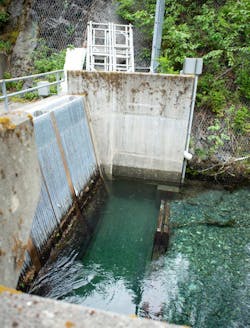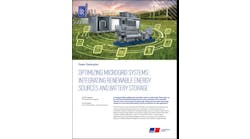Distributed Energy Resources and Microgrids Flex Their Muscles to Meet Growing Data Center Power Demand
As data center growth sparks worries that the power-hungry facilities will undermine both the grid and the environment, new applications of microgrids and other distributed energy resources (DER) – including hydropower-based microgrids – are seen as key to stemming the potential damage.
Such strategies could also provide advantages to internet-strapped rural communities that could benefit from becoming home to small data centers.
PG&E expects 3.5 GW of data center demand
Data centers could consume up to 9% of U.S. electricity generation by 2030–more than double what’s consumed now, according to the Electric Power Research Institute.
In California, Pacific Gas & Electric (PG&E) – whose Silicon Valley territory is home to a major data center market – is already experiencing that trend. PG&E’s load growth could almost double by 2040, the company said in a press statement. Over the next 5 years, PG&E has 3.5 GW of demand from data centers in its pipeline. Between 2023 and 2024, PG&E is expecting to see a 0.5% to 1.5% compound annual growth rate increase solely through data center growth.
And American Electric Power said it has 15 GW of new and incremental load commitment from incoming data center customers through the end of this decade. AEP’s entire systemwide peak load was 35 GW at the end of 2023.
Utilities, DER providers and data center builders are rolling out new ways to address the growth in power-hungry data centers.
Supplying power to noncritical data center loads with microgrids
Some of the ideas focus on serving demand from noncritical data center loads with DERs. Sidewalk Infrastructure Partners has created Verrus, a company that will construct new data centers designed to segregate critical and noncritical loads, then power them with microgrids that can employ the flexibility of batteries – along with flexible data center loads – to lower energy costs and carbon footprints.
For example, data centers can be built to separate server halls that house computing workloads such as web searches and flexible operations, including the process of training artificial intelligence models. Verrus can share power assets between these different halls to improve the utilization of generation assets. In this way assets aren’t sitting idle to meet the peak needs of certain server halls.
A modular, rural data center powered by renewable hydro
Another new idea comes from Cordova Electric Cooperative (CEC) – which serves rural Alaskan communities – and Greensparc, which creates small, modular data centers. They built a modular, edge data center that can possibly serve data-hungry Asian Pacific markets. CEC and Greensparc accomplished this goal with mostly renewable energy.
“It’s edge data, which combines the idea of microgrids and localized resources and applying it to data,” said Peter Asmus, executive director, Alaska Microgrid Group, who co-authored a white paper about the effort.
“With sites for large-scale data centers disappearing, the future is clearly edge data centers,” said the white paper. “Smaller, modular, and more efficient edge data centers are the wave of the future.” Industrial manufacturing, retail enterprises and other business efforts can be connected digitally in remote areas of the world with edge data centers.
In Cordova, CEC and Greensparc are deploying a 150-kW data center within CECs existing microgrid in Cordova, located at the mouth of the Copper River.
The data center will be 80% powered by excess run-of-the-river hydroelectric power that otherwise would be wasted, said Clay Koplin, CEO of CEC.
Meeting noncritical loads with excess hydropower
In the future, CEC expects to optimize the timing of the data center’s use so that it approaches or meets 100% hydropower, he added.
To achieve this goal, CEC plans to operate the flexible, or noncritical, data center loads when excess hydropower is available.
EnergyTech White Paper by NextEra 360
Resiliency Top of Mind: Data is Energy Industry's Best Defense
In general, locating modular data centers within a microgrid can lower data center energy costs by as much as 50% to 60% compared to a utility’s conventional tariff, said the white paper.
The savings come from eliminating transmission and distribution charges and avoiding the line losses associated with transmitting through the wires of a distribution network, said the white paper.
Economic and social benefits of small data centers in rural areas
The project is also expected to yield social and economic benefits. It can provide local hosting of business software to support web portals and direct marketing to local business-to-business hosted platforms. It can also include access to new AI tools, along with options for tech incubation.
In Cordova, the modular data center located within the microgrid will grow power sales to spread out the cost of CEC’s operations, keep rate increases in check and provide access to cloud services, artificial intelligence and “all that locally hosted cloud servers bring,” said Koplin.
Fuel cells provide low-carbon power
Fuel cells are also seen as a way to meet data center demand.
Bloom Energy announced a collaboration with Sembcorp Industries to potentially utilize the solid oxide fuel cell technology and carbon capture to provide low-carbon power for data centers in Singapore.
In May, semiconductor giant Intel Corp. and Bloom Energy announced a power capacity agreement focused on delivering fuel cell technology for Intel’s data center in Santa Clara, Calif.
Batteries store renewables for data centers
In addition, batteries can help meet the growing need to address data center demand.
GridBeyond, which offers a platform for managing DER, announced that it will provide battery energy storage to two data centers owned by Keppel DC REIT in Ireland. The batteries will provide flexible capacity to the power system, supporting the grid and allowing for the integration of additional renewable energy sources, said a press release.
Usually, when the grid is stressed, fossil fuels are used to balance the grid. But the batteries capture excess renewable energy that otherwise be wasted, providing lower carbon resources to help out the grid.
DERs and microgrids are flexing their muscles’ many abilities – providing clean power, lowering peak loads and reducing energy costs – playing an important role as demand accelerates for power to run data centers.









